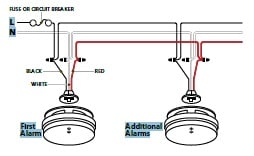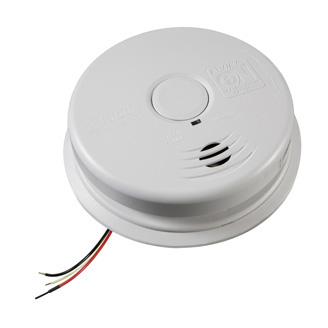Worry-Free Hardwired Interconnect Smoke Alarm Sealed Lithium Battery Backup
i12010S
Worry-Free 120V AC Wire-in Smoke Alarm Sealed Lithium Battery Backup Model i12010S
-
Ionization Sensing Technology.
-
Sealed-In 10-Year* Lithium Battery Backup.
-
Hush® Button.
-
Alarm Memory Indicator.
-
360° Mounting Plate with Tamper Resistance.
-
2 LED Indicators.
-
Part #: 21010407
The Kidde i12010S is an AC/DC powered, ionization smoke alarm that operates on a 120V power source with sealed-in lithium battery backup. This alarm uses ionization sensing technology. Ionization sensing alarms may detect invisible fire particles (associated with flaming fires) sooner than photoelectric alarms. Photoelectric sensing alarms may detect visible particles (associated with smoldering fires) sooner than ionization alarms. Leading authorities recommend that both ionization and photoelectric smoke alarms be installed to help insure maximum detection of the various types of fires that can occur within the home.
The i12010S contains a 10-year tamper proof battery that eliminates the need for battery replacement, and ends worry over unauthorized battery removal. The alarm provides continuous protection from smoke and fire, even during power outages. At the end of alarm life, the unit will chirp, indicating the alarm is in need of replacement. The customer can use a simple tool such as a screwdriver to deactivate the unit, stopping the chirp and making it safe for disposal. The end of life signal can be temporarily silenced to allow for replacement at a more convenient time.
Part Number (Ordering Number): 21010407
Easy Installation
-
Battery backup automatically activates when the alarm is attached to mounting bracket.
-
Large mounting base makes mounting easier, protects surface paint from dirt and covers imperfections.
-
Pre-stripped wiring harness with easy off cap does not require stripper tool. Tinned strands increase conductivity and wire nut grip.
Fewer Callbacks
-
10-year sealed battery substitutes need for routine 9V replacement.
-
Large centrally located Test/Hush® alarm control button silences nuisance alarms for approximately 9 minutes.
-
Dust cover protects sensor from contaminates during construction, reducing nuisance alarms.
User-Friendly Features
-
Red LED indicates alarm mode, Green LED indicates AC power is present.
-
Interconnectable with up to 24 devices (of which 18 can be initiating) including smoke, CO and heat alarms. See user guide for complete instructions.
-
End of Life Hush feature allows user to temporarily silence end of life chirp 3 days at a time for a maximum of 30 day life extension.
Technical Specifications
| Model: | i12010S |
| Power Source: | 120VAC (60 Hz, 45mA Max) |
| Sensor: | Ionization |
| Audio Alarm: | 85dB at 10ft |
| Temperature Range: | 40˚F (4.4˚C) to 100˚F (37.8˚C) |
| Humidity Range: | Up to 95% relative humidity (RH), non-condensing |
| Size: | 5.5” in diameter x 1.75” depth |
| Weight: | .45lbs |
| Interconnects: | Up to 24 Kidde devices |
| Warranty: | 10 year limited |
Architectural and Engineering Specifications
The smoke alarm shall be Kidde Model i12010S or approved equal. It shall be powered by a 120VAC, 60Hz source along with a 3V sealed lithium battery backup. The unit shall incorporate an ionization sensor with nominal sensitivity of 0.50 to 1.04%/ ft. The temperature operating range shall be between 40°and 100°F (4°C and 38°C) and the humidity operating range shall be up 95% relative humidity, non-condensing. The smoke alarm can be installed on any standard single gang electrical box, up to a 4” octagon junction box. The electrical connection (to the alarm) shall be made with a plug-in connector. A maximum of 24 Kidde devices can be interconnected in a multiple station arrangement. The interconnect system must not exceed the NFPA (National Fire Protection Association) limit of 18 initiating devices, of which 12 can be smoke alarms. With 18 initiating devices (Smoke, heat, CO, etc), interconnected, it is still possible to interconnect 6 strobe lights and/or relay modules. The alarm shall provide optional tamper resistance that deters removal of the unit from the wall or ceiling. No additional pieces shall be required to activate this feature. The alarm shall include a test button that will electronically simulate the presence of smoke and cause the unit to go into alarm. This sequence tests the unit’s electronics, battery and horn to ensure proper operation. The unit shall include a piezoelectric horn that is rated at 85 decibels at 10 feet. The unit shall include the Smart Hush™ feature that silences the unit for approximately 9 minutes if a nuisance condition occurs. The unit shall indicate a low battery condition with a brief alarm chirp and red LED flash once every 60 seconds. In standby condition, the green LED will be constantly on when powered by AC, and flash every 60 seconds when powered by only battery backup. The green LED will also flash every 2 seconds when in Hush mode, and every 16 seconds in Memory Condition. The smoke alarm shall include an End of Life Alert, where ten years after initial power-up the unit shall chirp two times every 30 seconds to indicate the alarm needs to be replaced. The End of Life signal can be silenced three days at a time for a maximum of 30 days. The unit shall have a deactivation switch to disable it and make it safe for disposal. The unit shall at a minimum meet the requirements of UL217, NFPA72, and (chapter 11), The State of California Fire Marshall, NFPA101 (0ne and two family dwellings), Federal Housing Authority (FHA), Housing and Urban Development (HUD). It shall also include a 10-year manufacturer’s limited warranty.
Installation of Smoke Alarm
The smoke alarm should be installed to comply with all local codes having jurisdiction in your area, Article 760 of the National Electric Code, and NFPA 72. Make certain all alarms are wired to a single, continuous (non-switched) power line, which is not protected by a ground fault interrupter. A maximum of 1000 ft. of wire can be used in the interconnect system. Use standard UL listed household wire as required by code.

The Kidde i12010S is an AC/DC powered, ionization smoke alarm that operates on a 120V power source with sealed-in lithium battery backup. This alarm uses ionization sensing technology. Ionization sensing alarms may detect invisible fire particles (associated with flaming fires) sooner than photoelectric alarms. Photoelectric sensing alarms may detect visible particles (associated with smoldering fires) sooner than ionization alarms. Leading authorities recommend that both ionization and photoelectric smoke alarms be installed to help insure maximum detection of the various types of fires that can occur within the home.
The i12010S contains a 10-year tamper proof battery that eliminates the need for battery replacement, and ends worry over unauthorized battery removal. The alarm provides continuous protection from smoke and fire, even during power outages. At the end of alarm life, the unit will chirp, indicating the alarm is in need of replacement. The customer can use a simple tool such as a screwdriver to deactivate the unit, stopping the chirp and making it safe for disposal. The end of life signal can be temporarily silenced to allow for replacement at a more convenient time.
Part Number (Ordering Number): 21010407
Easy Installation
-
Battery backup automatically activates when the alarm is attached to mounting bracket.
-
Large mounting base makes mounting easier, protects surface paint from dirt and covers imperfections.
-
Pre-stripped wiring harness with easy off cap does not require stripper tool. Tinned strands increase conductivity and wire nut grip.
Fewer Callbacks
-
10-year sealed battery substitutes need for routine 9V replacement.
-
Large centrally located Test/Hush® alarm control button silences nuisance alarms for approximately 9 minutes.
-
Dust cover protects sensor from contaminates during construction, reducing nuisance alarms.
User-Friendly Features
-
Red LED indicates alarm mode, Green LED indicates AC power is present.
-
Interconnectable with up to 24 devices (of which 18 can be initiating) including smoke, CO and heat alarms. See user guide for complete instructions.
-
End of Life Hush feature allows user to temporarily silence end of life chirp 3 days at a time for a maximum of 30 day life extension.
Technical Specifications
| Model: | i12010S |
| Power Source: | 120VAC (60 Hz, 45mA Max) |
| Sensor: | Ionization |
| Audio Alarm: | 85dB at 10ft |
| Temperature Range: | 40˚F (4.4˚C) to 100˚F (37.8˚C) |
| Humidity Range: | Up to 95% relative humidity (RH), non-condensing |
| Size: | 5.5” in diameter x 1.75” depth |
| Weight: | .45lbs |
| Interconnects: | Up to 24 Kidde devices |
| Warranty: | 10 year limited |
Architectural and Engineering Specifications
The smoke alarm shall be Kidde Model i12010S or approved equal. It shall be powered by a 120VAC, 60Hz source along with a 3V sealed lithium battery backup. The unit shall incorporate an ionization sensor with nominal sensitivity of 0.50 to 1.04%/ ft. The temperature operating range shall be between 40°and 100°F (4°C and 38°C) and the humidity operating range shall be up 95% relative humidity, non-condensing. The smoke alarm can be installed on any standard single gang electrical box, up to a 4” octagon junction box. The electrical connection (to the alarm) shall be made with a plug-in connector. A maximum of 24 Kidde devices can be interconnected in a multiple station arrangement. The interconnect system must not exceed the NFPA (National Fire Protection Association) limit of 18 initiating devices, of which 12 can be smoke alarms. With 18 initiating devices (Smoke, heat, CO, etc), interconnected, it is still possible to interconnect 6 strobe lights and/or relay modules. The alarm shall provide optional tamper resistance that deters removal of the unit from the wall or ceiling. No additional pieces shall be required to activate this feature. The alarm shall include a test button that will electronically simulate the presence of smoke and cause the unit to go into alarm. This sequence tests the unit’s electronics, battery and horn to ensure proper operation. The unit shall include a piezoelectric horn that is rated at 85 decibels at 10 feet. The unit shall include the Smart Hush™ feature that silences the unit for approximately 9 minutes if a nuisance condition occurs. The unit shall indicate a low battery condition with a brief alarm chirp and red LED flash once every 60 seconds. In standby condition, the green LED will be constantly on when powered by AC, and flash every 60 seconds when powered by only battery backup. The green LED will also flash every 2 seconds when in Hush mode, and every 16 seconds in Memory Condition. The smoke alarm shall include an End of Life Alert, where ten years after initial power-up the unit shall chirp two times every 30 seconds to indicate the alarm needs to be replaced. The End of Life signal can be silenced three days at a time for a maximum of 30 days. The unit shall have a deactivation switch to disable it and make it safe for disposal. The unit shall at a minimum meet the requirements of UL217, NFPA72, and (chapter 11), The State of California Fire Marshall, NFPA101 (0ne and two family dwellings), Federal Housing Authority (FHA), Housing and Urban Development (HUD). It shall also include a 10-year manufacturer’s limited warranty.
Installation of Smoke Alarm
The smoke alarm should be installed to comply with all local codes having jurisdiction in your area, Article 760 of the National Electric Code, and NFPA 72. Make certain all alarms are wired to a single, continuous (non-switched) power line, which is not protected by a ground fault interrupter. A maximum of 1000 ft. of wire can be used in the interconnect system. Use standard UL listed household wire as required by code.





